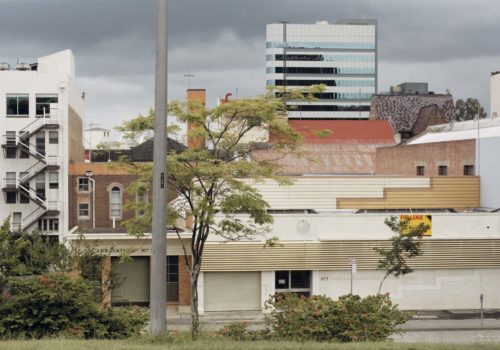Over the past four decades, the subject of “landscape” has become one of the major issues in contemporary photography. Although several exhibitions have already examined one aspect of the European and American approaches to this subject, they did not necessarily reveal the importance of the conceptual and formal renewal related to this issue. This exhibition cycle is an attempt at synthesis, and was carried out using several works found in public collections in France.
The medium of photography, with its foundation in reality, has rediscovered the treatment of “landscape” as a genre. Beyond the integration of this specific issue, the development of fictional narratives and practices, linked to a renewable pictorial aesthetic, is remarkable. This phenomenon is part of a logic of historical continuity that developed simultaneously with the strictly documentary photographic practices linked to the necessity to account for the land in its objective and socio-economic dimensions. The beginnings of this renewal of genre began in the 1970s, but it was in the 1980s that their paths began increasingly to cross, revealing new approaches and unique methods. If certain approaches emerged circumstantially, others began as commissions in conjunction with the European Landscape Convention. The magnitude of this current allowed for the appearance of major artists whose work remains focused on the exploration of this issue.
The Landscape has become a crucible of contemporary artistic thought. The latter finds the basis of its development in Pliny’s theory of the cosa mentale, which points to the necessity of considering our own cultural perceptions of nature and the aesthetic shaping of reality. Following extensive research in a number of public collections in France, it became possible to divide the different approaches into four different groups: The Documentary Landscape, The Fictional Landscape, The New Picturesque, and The Political Landscape
—Documentary Landscape is based on the documentary approaches in their objective, typological and political dimensions. This axis highlights the radicalism of the methodologies and the willingness of “territorial” approaches to objectify the landscape. The analytical works are highlighted to demonstrate the importance of the analysis of codes in the manufacturing of landscapes as well as the concept of the image as a document. Other works show the importance of more specifically typological and critical approaches.
—Fictional Landscape demonstrates the links that narrative practices share with art history, in particular with cinema. This group grants a place to the particular styles in relation to the poetic, but also to the narrative and to History, highlighting the compositions of reconstructed landscapes using the principles of mise-en-scène and other new technologies.
—The New Picturesque reveals the appearance of trends from the 1990s that redefine the documentary vision by “surpassing” it by means of a formal property. Kinds of documentary “drifts” informed by the aesthetic desire on the part of their creator, these creations question the concept of the picturesque through a Neo-Romantic posture. In some instances, the disruption of visual norms provokes perceptual shifts that call up another form of the picturesque that could be defined as modern.
—The Political Landscape focuses on the traces of memories inscribed in the landscapes that result from the work that result from works that involve an objective approach as much as a critical position with regards to the impact of our political and economic actions on the environment. Some artists associate the documentary objectification and societal analysis in their engagement with politics. This group takes into account two current critical trends: the ecological impact of economic development and the scars of war on a given landscape.
Christine Ollier
Paysage-Document
Commissariat de l’exposition : Hélène Jagot et Christine Ollier
Du 2 juin au 2 septembre 2012
Robert Adams, Lewis Baltz, Gabriele Basilico, Bernd & Hilla Becher, Jean-Marc Bustamante, Claire Chevrier, Arnaud Claass, Robin Collyer, Thibaut Cuisset, John Davies, Ger Dekkers, Georges Dupin, Gilbert Fastenaekens, Anne-Marie Filaire, Hamish Fulton, Andreas Gursky, Axel Hütte, Joachim Koester, Jürgen Nefzger, Walter Niedermayr, Paola de Pietri, Sophie Risthelhueber, Thomas Ruff, Edward Ruscha , Marc Ruwedel, Stephen Shore, Thomas Struth, Holger Trülzsch, Jeff Wall, Ian Wallace.
Musée de la Roche-sur-Yon
Rue Jean-Jaurès
85000 La Roche-sur-Yon
tél./ fax.: 02.51.47.48.35. / 02.51.47.45.99
[email protected]
















